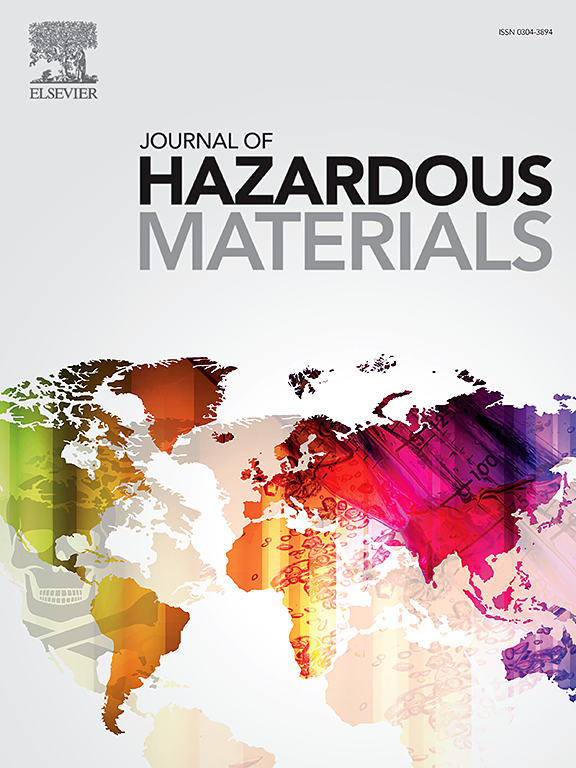慢性砷暴露致肺铁下沉的体内外翻译研究及肠-肺轴相关性的多组学分析
IF 11.3
1区 环境科学与生态学
Q1 ENGINEERING, ENVIRONMENTAL
引用次数: 0
摘要
慢性砷暴露是一个全球性的健康问题,与纤维化等肺部疾病有关。然而,其确切的分子机制尚不清楚。本研究探讨了慢性砷暴露对小鼠模型(通过饮食)和BEAS-2B细胞的影响,重点关注氧化应激、脂质过氧化、线粒体功能障碍和死铁介导的细胞死亡。方法将beas - 2b细胞暴露于1 μmol/L NaAsO₂中30代。氧化应激通过ROS定量、GSH消耗和T-SOD活性来评估。脂质过氧化用BODIPY荧光和MDA水平测定。mtROS成像和JC-1染色检测线粒体功能障碍。通过GPX4表达和基于tem的线粒体完整性分析铁下垂。一个14个月大的小鼠模型评估了组织病理学、代谢组失调和肠-肺轴串扰。结果砷暴露显著增加ROS,减少GSH,降低T-SOD活性。脂质过氧化和线粒体功能障碍明显,GPX4下降约60%。小鼠肺组织学表现为肺泡增厚、炎症浸润、IL-6、TNF-α和VEGF升高。代谢组学分析显示脂质代谢紊乱,与铁下垂标志物相关。本研究首次通过14个月大的小鼠模型和30代细胞模型证明铁凋亡是砷诱导的肺上皮损伤的关键机制。我们进一步证明,慢性暴露诱导的铁下垂在功能上是不可逆的,因为与先前的急性暴露模型不同,铁抑素-1抑制铁下垂未能挽救GPX4的表达。本文章由计算机程序翻译,如有差异,请以英文原文为准。

A Translational In Vitro to In Vivo Study on Chronic Arsenic Exposure Induced Pulmonary Ferroptosis and Multi-Omics Analysis of Gut-Lung Axis Correlation
Background
Chronic arsenic exposure is a global health concern linked to pulmonary diseases like fibrosis. However, its precise molecular mechanisms remain unclear. This study explored the effects of chronic arsenic exposure on a murine model (via diet) and BEAS-2B cells, focusing on oxidative stress, lipid peroxidation, mitochondrial dysfunction, and ferroptosis-mediated cell death.Methods
BEAS-2B cells were exposed to 1 μmol/L NaAsO₂ for 30 passages. Oxidative stress was assessed via ROS quantification, GSH depletion, and T-SOD activity. Lipid peroxidation was measured using BODIPY fluorescence and MDA levels. Mitochondrial dysfunction was determined by mtROS imaging and JC-1 staining. Ferroptosis was analyzed through GPX4 expression and TEM-based mitochondrial integrity. A 14-month murine model evaluated histopathology, metabolomic dysregulation, and gut-lung axis crosstalk.Results
Arsenic exposure significantly increased ROS, depleted GSH, and reduced T-SOD activity. Lipid peroxidation and mitochondrial dysfunction were evident, with a ~60% decline in GPX4. Murine lung histology showed alveolar thickening, inflammatory infiltration, and elevated IL-6, TNF-α, and VEGF. Metabolomic analysis revealed disrupted lipid metabolism, correlating with ferroptosis markers.Conclusions
This was the first study to demonstrate ferroptosis as a key mechanism in arsenic-induced lung epithelial damage using a 14-month murine model and a 30-passage cellular model. We further demonstrated that ferroptosis induced by chronic exposure becomes functionally irreversible, as ferroptosis inhibition by Ferrostatin-1 failed to rescue GPX4 expression, unlike prior acute exposure models.求助全文
通过发布文献求助,成功后即可免费获取论文全文。
去求助
来源期刊

Journal of Hazardous Materials
工程技术-工程:环境
CiteScore
25.40
自引率
5.90%
发文量
3059
审稿时长
58 days
期刊介绍:
The Journal of Hazardous Materials serves as a global platform for promoting cutting-edge research in the field of Environmental Science and Engineering. Our publication features a wide range of articles, including full-length research papers, review articles, and perspectives, with the aim of enhancing our understanding of the dangers and risks associated with various materials concerning public health and the environment. It is important to note that the term "environmental contaminants" refers specifically to substances that pose hazardous effects through contamination, while excluding those that do not have such impacts on the environment or human health. Moreover, we emphasize the distinction between wastes and hazardous materials in order to provide further clarity on the scope of the journal. We have a keen interest in exploring specific compounds and microbial agents that have adverse effects on the environment.
 求助内容:
求助内容: 应助结果提醒方式:
应助结果提醒方式:


